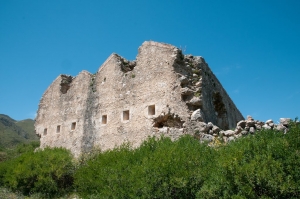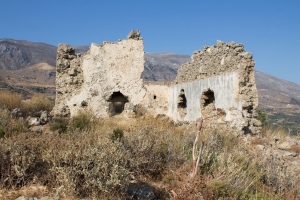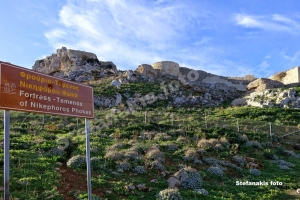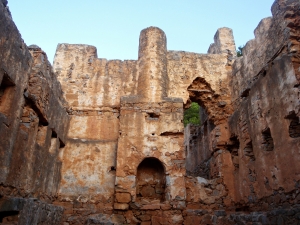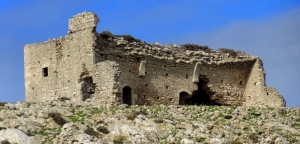The most important passage of Rethymnon prefecture was that of Agios Vasilios (south), through where Turks and Greeks traveled from Mesara plain to Sfakia area. Thus, several towers (kouledes) were built. Such one Koules was built near the entrance of the gorge Kourtaliotis, near the village Koxare. The tower was partially destroyed by the Cretan rebels in 1896.
Crete in ancient times was not threatened by external enemies. The first external enemies of the island were the Romans. Therefore, till then, the fortification of cities was focused on internal enemies. After the Roman Empire (67 BC-330 AD) things changed radically. Crete became a province of the Eastern Roman Empire, which later transformed to the Byzantine Empire. At the same time, several civilizations started developing around the Mediterranean Sea.
Thus, Crete, because of its natural and geopolitical position, acquired great importance and became an "apple of discord" for the civilizations of the Mediterranean. During the First Byzantine Period (330-824) things looked calm. For that reason, combined with the internal and external problems of the Empire, the island was on the fringes of the Byzantine interest. Thus, pirate raids increased and the seaside monasteries were fortified to protect themselves.
Under these circumstances, the first storm on the island was imminent. The Saracen pirates managed to easily occupy Crete in 824, that was almost defenseless. They settled for 140 years, till 961, during which they fortified the largest town, today’s Heraklion. After continuous failures to reoccupy Crete, Nikiforos Fokas managed to liberate the island from pirates in 961. Then, the Byzantines built new walls, which managed to keep invaders away for a few more centuries.
In 1206, Crete passed into the hands of the Genoese, who immediately gave particular importance to the fortification of the island. Within a few years the fortified three castles and 12 fortresses, but still the Venetians managed to occupy the island in 1209. The Venetian Era in Crete lasted for 4.5 centuries and was mainly dependant on the colossal fortification structures. The best Venetian engineers built the Great Castle of Candia (Heraklion). The Turks managed to take over Candia in 1669 after 22 years (!) of besieging and immediately started restoring the Venetian Forts and built a lot of small fortresses across the Cretan Territory, called Koules. The Turks took care of their forts till the end of their presence on the island.
Even today, visitors can get an idea of what the fortified cities of Crete were like, as the walls are still in excellent condition. The impressive castles in Chania, Rethymnon and Heraklion and the fortresses on the islands of Souda, Gramvousa, Spinalonga are but a few samples of Cretan fort architecture.
In the province of Mylopotamos, one more mountainous provinces in Crete, there were two fortresses. The first was built in the seaside village of Panormos, while the second near th village Saint Mamas.
Embrosneros hosted the chateau of one of the most terrible janissaries in Crete, the Turk Ibrahim Alidakis. Alidakis owned a vast property, which he had stolen from the Greeks, and became the greatest aga of the area. In the nearby plateau of Vothonas, Alidakis raised his horses.
One of the many Turkish towers (Koules) built by the Turks in Crete is that of Plakias at South Rethymno. It was built on a hill of conglomerate grounds, with steep cliffs at its east and south sides, inside a fortified enclosure.
The village of Kanli Castelli, today known as Prophet Elijah, is located about 18km south of Heraklion, at the start of Malades valley. The village is situated at the foot of the steep two-peaked hill Rocca, on which even today there ruins of the fort Kanli Castelli, after which Prophet Elijah took its old name.
On the west side of the exit of Samaria Gorge, above the current village of Agia Roumeli, the Turks built the Koules of Agia Roumeli to suppress the rebels hiding in the gorge. This Koules is in quite good condition. There were three more towers in wider area of Agia Roumeli (in Skoteini, Aggelokambos and Sideris positions)
Zou is a small green village located 7km south of Sitia. Its name probably derives from the Turkish word su, which means water, as water abounds here, flowing from the famous springs of Zou.
The Fortress at position Tholi is located at the homonym region west of the Alagni village and dates back from the 16-17th century. The two-storey building, parts of which are still in bad shape, was protected by a wall.





